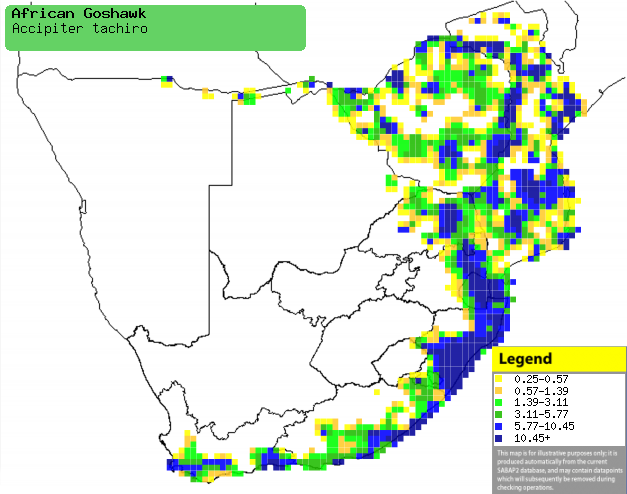|
Accipiter tachiro (African
goshawk)
Afrikaanse sperwer [Afrikaans]; iKlebe, iMvumvuyane [Zulu];
Kakodi (generic term for sparrowhawks, goshawks, kestrels and falcons)
[Kwangali]; Fiolo-ea-meru [South Sotho]; Rukodzi (generic name for a small
raptor such as falcon or sparrowhawk) [Shona]; Phakwę (generic term for
some of the smaller raptors) [Tswana]; Afrikaanse havik [Dutch]; Autour
tachiro [French]; Afrikanischer sperber, Tachirosperber [German];
Açor-africano [Portuguese]
Life
> Eukaryotes >
Opisthokonta
> Metazoa (animals) >
Bilateria >
Deuterostomia > Chordata >
Craniata > Vertebrata (vertebrates) > Gnathostomata (jawed
vertebrates) > Teleostomi (teleost fish) > Osteichthyes (bony fish) > Class:
Sarcopterygii (lobe-finned
fish) > Stegocephalia (terrestrial
vertebrates) > Tetrapoda
(four-legged vertebrates) > Reptiliomorpha > Amniota >
Reptilia (reptiles) >
Romeriida > Diapsida > Archosauromorpha > Archosauria >
Dinosauria
(dinosaurs) > Saurischia > Theropoda (bipedal predatory dinosaurs) >
Coelurosauria > Maniraptora > Aves
(birds) > Order: Falconiformes
> Family: Accipitridae
> Genus: Accipiter
Widely distributed in Africa south of the Sahara in woodland,
forest, alien plantations and wooded urban areas. Makes its presence known in an
area by taking early morning flights high above the ground and emitting its
clicking call (like two stones hit together at 2-3 second intervals). Preys
mainly on birds (up to the size of francolins and domestic chickens and
including nestlings) but also on small mammals (bats, squirrels, mice) and
lizards. More rarely feeds on snakes, frogs, earthworms and insects.
Distribution and habitat
Occurs from Ethiopia and Eritrea, south through Kenya,
Uganda, Tanzania, southern DRC, Zambia, Malawi and Angola to South Africa.
In southern Africa, it is scarce to locally common in north-eastern Namibia (including the Caprivi Strip), Zimbabwe, Mozambique and South Africa. It generally favours forest, suburban areas and
stands of alien trees, such as Acacia in the Western Cape.
|
 |
|
Distribution of African goshawk in southern Africa,
based on statistical smoothing of the records from first SA Bird Atlas
Project (©
Animal Demography unit, University of
Cape Town; smoothing by Birgit Erni and Francesca Little). Colours range
from dark blue (most common) through to yellow (least common).
See here for the latest distribution
from the SABAP2. |
Predators and parasites
Movements and migrations
Resident and largely sedentary, although juveniles
disperse from their parents territory when they become fully
independent.
Food
It mainly eats birds, supplemented with mammals and
lizards, doing most of its hunting from perches concealed by dense vegetation so
that it can ambush its prey. Pairs rarely hunt cooperatively at large
aggregations of animals, such as bat roosts. The following food items have been recorded
in its diet:
- Vertebrates
- birds
- mammals
- reptiles
- toads
- Invertebrates
Breeding
- Monogamous, territorial solitary nester, performing a courtship display in
which either the male, female or both of them together fly in an undulated
flight while calling loudly, sometimes finishing with a steep dive.
- The nest is built mainly by the female, consisting of a stick platform
thickly lined with green leaves, such as pine needles, lichen and mistletoe.
It is typically placed on a branch away from the main trunk of a tree,
especially if it has dense foliage, although it may also build it on top
of an old Hadeda ibis
nest,
sometimes taking over the nest of a Little
sparrowhawk instead of build its own. It has been recorded to nest in
the following trees:
- indigenous trees
- Acacia
- A. tortilis (Umbrella thorn)
- A. nigrescens (Knob-thorn)
- A. polyacantha (White-stem thorn)
- A. robusta (River thorn)
- Combretum imberbe (Leadwood)
- Kirkia acuminata (White kirkia)
- Faidherbia albida (Ana-tree)
- Breonadia salicina (Matumi)
- Syzygium cordatum (Waterberry)
- Syzygium guineense (Pointed-leaf waterberry)
- Diospyros mespiliformis (Jackal-berry)
- Newtonia hildebrnadtii (Sandveld newtonia)
- Ficus (figs)
- Euphorbia cooperi (Bushveld candelabra euphorbia)
- alien trees
- Eucalyptus
- Pinus (pines)
- Jacaranda acutifolia (Jacaranda)
- Egg-laying season is from July-December, peaking from
September-November.
- It lays 1-3 eggs, which are incubated mainly or solely by the female for
about 35-37 days, while the male feeds her regularly at the nest.
- The chicks are fed by both parents, leaving the nest after about 30-35
days but remaining in the nest tree vicinity for another six weeks or so.
The young become fully independent roughly 1-3 months after fledgling.
Threats
Not threatened, although in Zimbabwe it is threatened by
pesticide contamination, while in the Eastern Cape its range has decreased to
habitat loss.
References
-
Hockey PAR, Dean WRJ and Ryan PG 2005. Roberts
- Birds of southern Africa, VIIth ed. The Trustees of the John Voelcker
Bird Book Fund, Cape Town.
|
